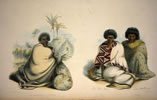King Pōtatau was succeeded by his son, Tāwhiao, who was proclaimed king on 5 July 1860 at Ngāruawāhia. Wiremu Tāmihana Tarapīpīpī Te Waharoa anointed him in the whakawahinga ceremony, using the same bible that he had used for Pōtatau’s investiture.
The invasion of Waikato
The first years of Tāwhiao’s reign were dominated by war. Governor Thomas Gore Browne demanded that Tāwhiao submit 'without reserve' to Queen Victoria.1
Gore Browne’s successor, George Grey, was also not prepared to accept dual sovereigns in New Zealand. On a visit to Ngāruawāhia, Grey famously declared that ‘I shall not fight against [the king] with the sword, but I shall dig round him till he falls of his own accord.’2 Grey spent little time testing this isolating policy. He soon ordered his troops to cross the Mangatāwhiri Stream (which Tāwhiao had established as an aukati) in July 1863.
The invasion of Waikato ensued, with major battles leading to an ultimate defeat for Waikato iwi. Tāwhiao and his fellow ‘Kingites’ were forced to retreat across the Pūniu River into Te Nehenehenui, the lands of their Ngāti Maniapoto relatives.
Land confiscation
Tāwhiao and his followers were declared rebels and some 1.2 million acres (almost 500,000 hectares) of their fertile lands were confiscated. The return of these confiscated lands became a central concern for Tāwhiao and subsequent Waikato leaders. Their catch cry was, ‘I riro whenua atu, me hoki whenua mai’3 (as land was taken then land should be given back).
Tāwhiao and Ngāti Maniapoto leaders established an aukati along the confiscation line at the Pūniu River, forbidding European intrusion. The territory beyond the aukati subsequently became known as the King Country.
Formal peace
From his exile, a more pacifist Tāwhiao declared that killing must cease. However, he also argued against land surveys, land sales, courts, gold mining, telegraphs, schools, and the Pākehā justice system. Suspicious of the Pākehā, Tāwhiao stated in 1869 that Māori and Pākehā should remain separate. However, in 1881, after a number of years of negotiations with the government, Tāwhiao and his followers symbolically laid down their weapons before the resident magistrate at Pirongia (Alexandra) and returned to Waikato.
Trip to England
Tāwhiao did not renounce his efforts to have Waikato’s confiscated lands returned. In 1884 he travelled to England with several companions to seek redress from Queen Victoria. Tāwhiao’s tattooed face caused heads to turn in London, but he and his Māori embassy were declined an audience with the queen. He was informed by the colonial secretary that confiscations were a domestic matter under the jurisdiction of the New Zealand government.
On his return home, Tāwhiao introduced the poukai - an institution to comfort the widowed, bereaved and destitute and a chance to discuss redress and the repatriation of land. The first poukai was held at Whatiwhatihoe in 1885. They continue in the 21st century, with almost 30 marae holding an annual poukai and being visited by the sovereign. Poukai involve flag raising and lowering ceremonies, karakia of the Pai Marire religion, pōwhiri and kawe mate (mourning ceremonies), hākari (feasts), and the discussion of political, social and spiritual topics in the presence of the monarch. They give the king or queen the opportunity to hear about local issues and allow the marae to show their support for the Kīngitanga.
Pōtatau's advice
As Pōtatau was nearing death he gave Tāwhiao and his people some advice. ‘I muri, kia mau ki te whakapono, kia mau ki te aroha, ki te ture. Hei aha te aha, hei aha te aha.’4 (After I am gone, hold fast to faith; hold fast to love; hold fast to law. Nothing else matters now – nothing.)
Political independence
Tāwhiao continued his quest for mana motuhake (Māori political independence), setting up the Kauhanganui, a Kīngitanga parliament, in 1892. This had a council of 12 tribal representatives known as Te Tekau-mā-rua, as well as ministers. Tupu Taingākawa, the second son of Wiremu Tāmihana (and the kingmaker at the time), was the tumuaki (premier). Tāwhiao was offered, and accepted, a government pension. There was much iwi concern at the implication that he had given up his independence, and the pension was paid back, with interest.
Prophetic sayings
Tāwhiao is famous for his many tongi (prophetic sayings). For example, with the issue of Waikato’s confiscated lands unresolved, and faced with poverty, Tāwhiao spoke of rebuilding using the less well-known, more humble trees:
Māku anō e hanga tōku whare
Ko tōna tāhuhu, he hīnau.
Ōna pou he māhoe, he patatē.5
I will build my house
Its ridge pole will be made of hīnau
Its posts will be made of māhoe (whiteywood) and patatē (seven-finger).
Tāwhiao’s sayings have guided the Kīngitanga over many years.
Death
King Tāwhiao died on 26 August 1894 at Pārāwera. He was buried on Taupiri mountain, the sacred burial ground of the Waikato, where King Pōtatau was to be reinterred in 1903. Some 3,000 Māori from all parts of the country attended Tāwhiao’s tangihanga.



